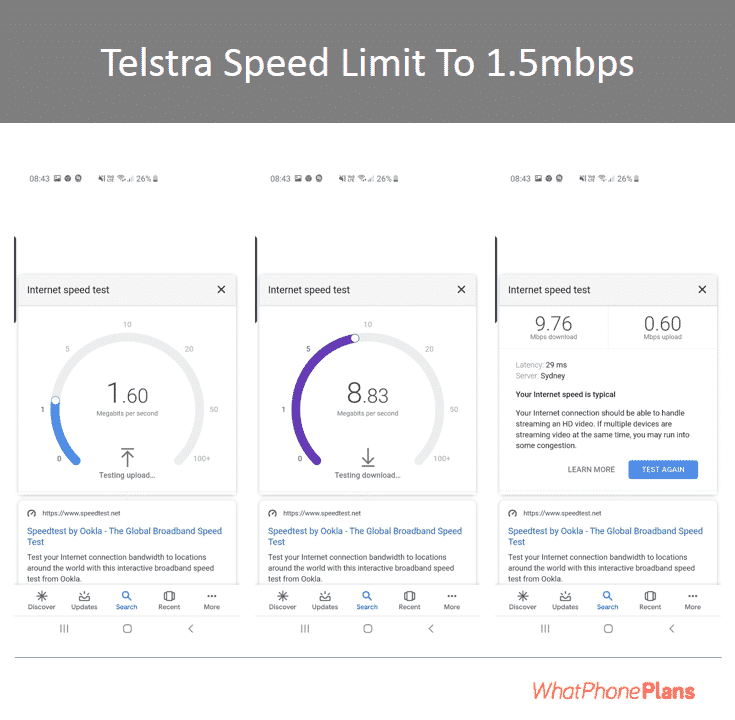Rather than cutting you off, the big telcos now have plans that reduce your download speed to 1.5Mbps once you hit your data limit – which is more than enough to do the basics with your phone.
You buy a phone plan with 25Gb of data. You use up the data 4 days before the plan renews. Rather than cut you off, Telstra, Optus and Vodafone have plans that instead limit your download speed to 1.5Mbs (rather than the usual 10 to 50Mbps). They’re often called ‘endless’ or ‘infinite’ data plans.
Honestly, it’s not the worst deal. You won’t have to pay excess data charges (usually $10 per Gb) or recharge your plan early. But the downside is you won’t be able to do everything as easily as you can at full 4G/5G download speeds.
⚡ Plans that reduce data speed are different to genuinely unlimited data plans. You can compare unlimited plans (with no speed reduction) here.
What can (and can’t) you do with 1.5Mbps?
Here’s what you can do:
- Browse the internet
- Use social media
- Stream music
- Stream movies and shows
- Use YouTube
Here’s what you can’t do:
- Stream in high-definition
- Play online games smoothly
- Expect some things to load quickly, like social media reels
Let’s take a look at each in more detail.
This Month’s Hot Offers
Streaming movies and shows at 1.5Mpbs
While you can likely stream movies, don’t expect great quality.
Netflix says you need 3Mbps or higher for high definition streaming.
Stan says you need at least 2Mbps for “good picture quality”.
Disney says you need at least 5Mbps for a high definition picture.
So while you can technically watch a movie, you might find it’s a pixelated (and frustrating) experience. It might also take longer to load.
Our advice is to go somewhere with free internet and download your shows to get you through until your plan renews.
Streaming music at 1.5Mpbs
Streaming music shouldn’t be an issue at these speeds. Modern streaming services like Spotify and Apple Music can drop the bit rate of the music file in case of a slow connection or a congested network.
Using social media at 1.5Mpbs
General scrolling of platforms like Facebook, Instagram, Pinterest and Tik Tok should be fine at these speeds. But, if you don’t have a ton of patience you might find the slower load speed frustrating. A Facebook page that loads up in 2.13 seconds on an average 4G network will take somewhere around 5.02 seconds on a 1.5 Mbps network. Videos can take even longer.
Should you get an ‘endless data’ plan for your smartphone?
If you constantly find yourself running out of data early, it might be time to look at updating your phone plan. There are so many brands now that offer big data at low prices, with great discounts.
If you only occasionally use up your data, then a capped download speed might be a good investment. You don’t have to worry about your data usage or being charged extra.
This is especially useful for people who are away from WiFi and still want to use their phone. People who commute for long hours, or who like to use their phone on their lunch hour away from the office might get the best use from a plan with reduced download speeds.
That said, these plans might not be the best choice for people who want high definition resolution. Standard definition video streaming is the most you can hope for, and you will have to wait to connect to a WiFi network for anything beyond that.
Real Life Experience
To test how Telstra’s unlimited plan would perform in the real world, WhatPhone signed up for a plan to be used mostly in Sydney. Here are some observations on what happened when the full-speed data allowance was all used up.
- 1. You might not be limited to 1.5 Mbps after all.
In our real world test, even after the data allocation was used up the smartphone was still able to achieve download speeds of up to 9.76Mbps – much higher than the specified 1.5 Mbps. This speed should be enough to support HD streaming and most internet usage. Of course, there is no guarantee that it won’t be shaped back to the minimum speeds at times, but reaching your allowance doesn’t necessarily have to mean changing how you use your phone.
While Telstra promises to slow data down to 1.5 Mbps, you could still be able to achieve higher speeds.
- 2. You can buy more data to get the speed back – but it’s expensive.
If you signed up to one of these plans and used your data but needed to access top-speed internet, Telstra has an option to cover you. However, it won’t come cheap. On top of the slightly more expensive plan allowing you unlimited data, you would have to add on an extra $10 per 1GB of additional data. At these prices, it wouldn’t be worth doing often. - 3. Customer service can be improved.
Once the limit was reached, there was no warning from Telstra. This communication breakdown could be an issue for people who could be relying on faster speeds, only to have them slowed down without any notice. It’s a basic thing for Telstra to offer, and frustrating for customers if their speed is cut without warning. Customers are also unable to change their plans from the app, but have to contact Telstra Support directly.
